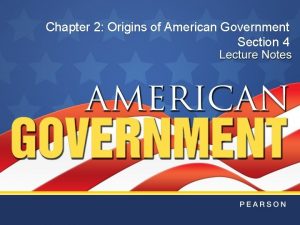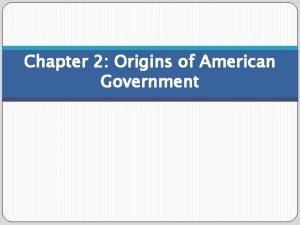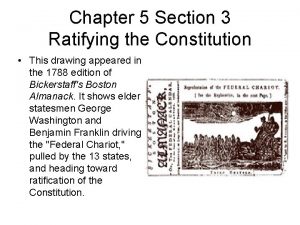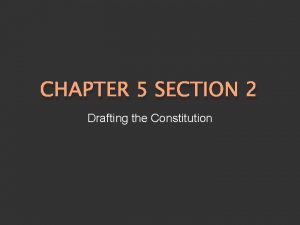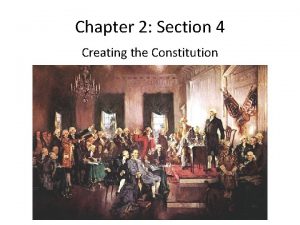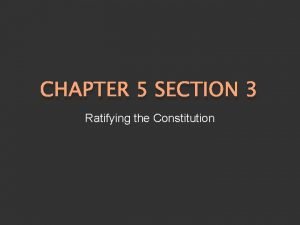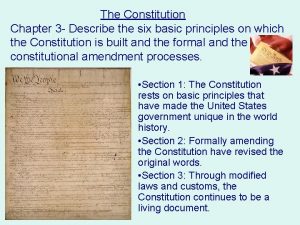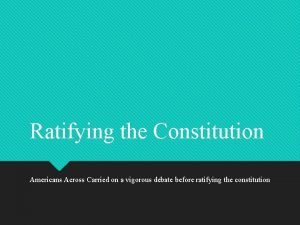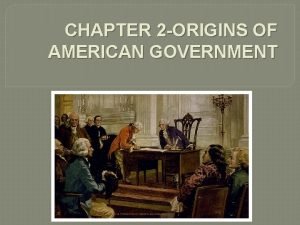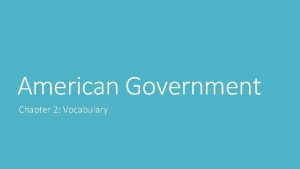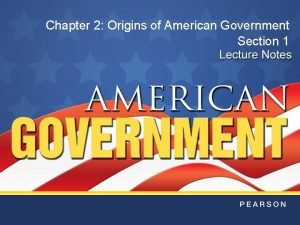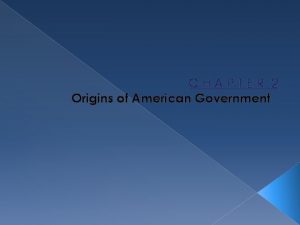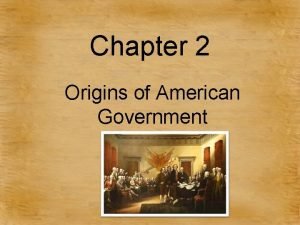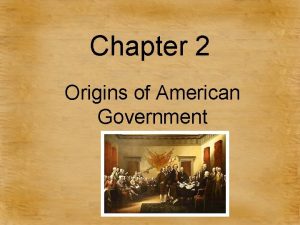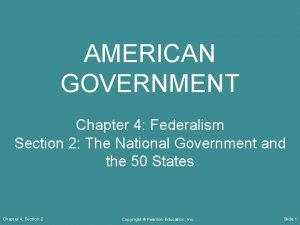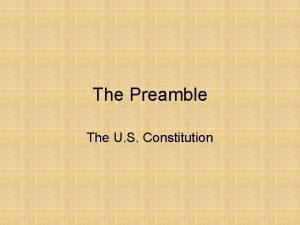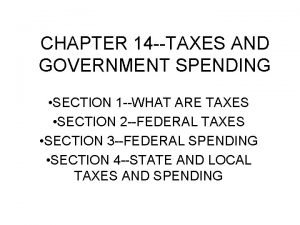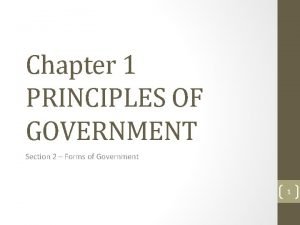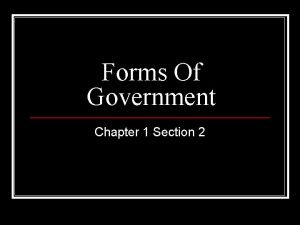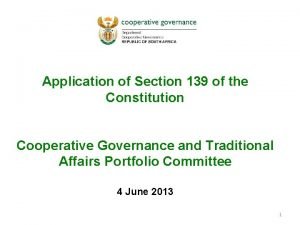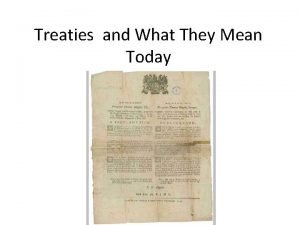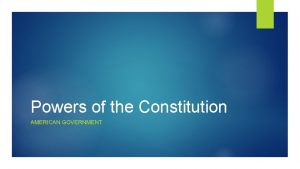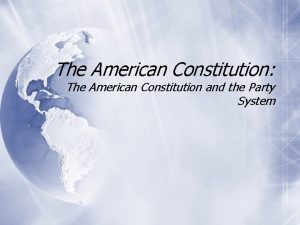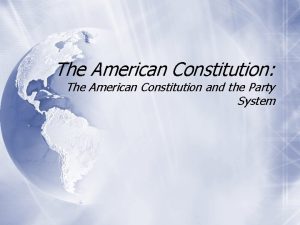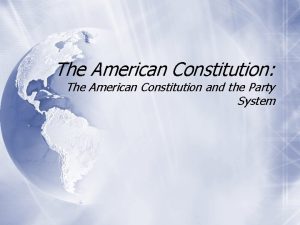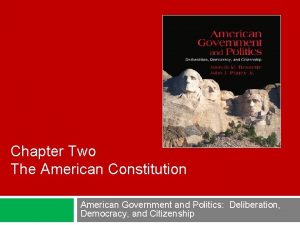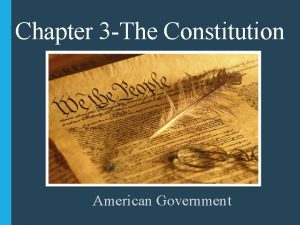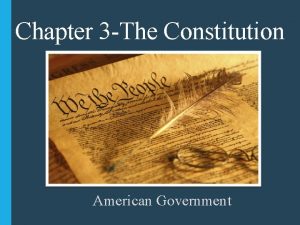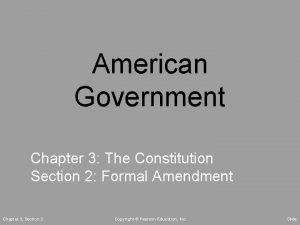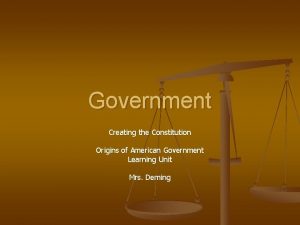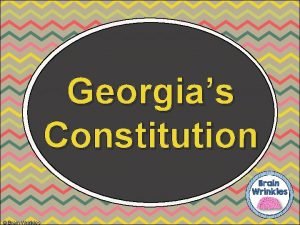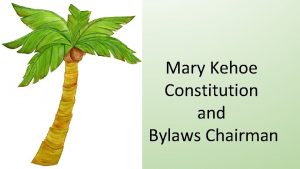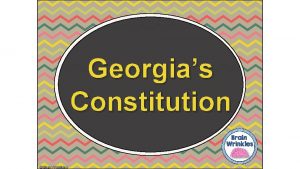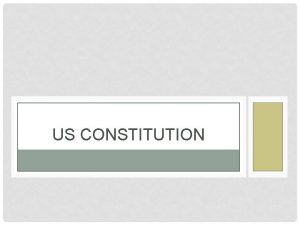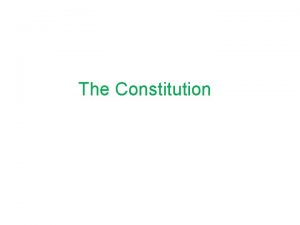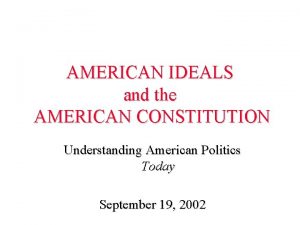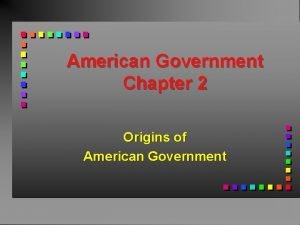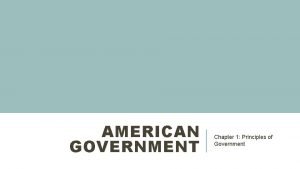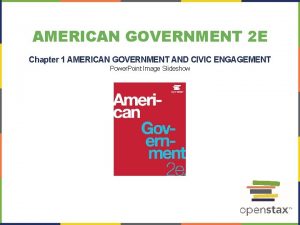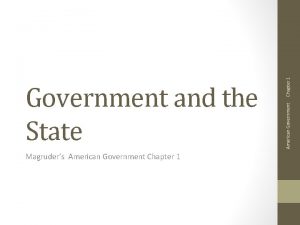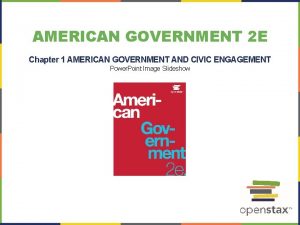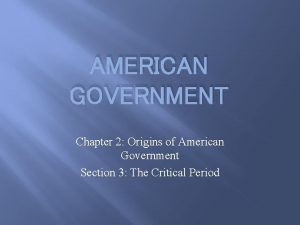Chapter 3 The Constitution American Government Section 1






























- Slides: 30

Chapter 3 -The Constitution American Government

Section 1 -Basic Principles The Constitution is “the supreme law of the land” – the highest form of law in the United States. It lays out the basic framework and procedures of our government.

An Outline of the Constitution The Constitution is separated into: I. “Preamble”: A short introduction. II. “Articles”: Seven numbered sections that outline the American government. III. “Amendments”: A total of twenty-seven additions to the document.

The Seven Articles of the Constitution • Article I- Created the Legislative Branch • Article II- Created the Executive Branch • Article III- Created the Judicial Branch • Article IV- Addressed relationships between the states • Article V- Covers the process of amending the Constitution • Article VI- Addressed several issues that included the national debt, supremacy of national laws and oaths of office • Article VII- Explains the process of ratifying the Constitution

The Six Basic Principles of the Constitution I. Popular Sovereignty II. Limited Government III. Separation of Powers IV. Checks and Balances V. Judicial Review VI. Federalism

I. Popular Sovereignty: • All political power resides in the people Government can only govern with the consent of the governed. *All forms of government national, state, and local operate according to this principle.

II. Limited Government: • Government is not all-powerful It may only do those things that the people have given it the power to do. *Government must obey the law–it must follow the principle of “constitutionalism”: government must be conducted according to constitutional principles. * “Rule of law”: government and its officers are always subject to–never above–the law.

III. Separation of Powers: The basic powers of government are separated among three independent branches in our presidential system. *This separation of powers created the legislative, judicial and executive branches

III. Separation of Powers: • Article I: The legislative branch makes the laws (Congress). • Article II: The executive branch executes/administers laws (The President). • Article III: The judicial branch interprets/applies the laws (Supreme Court). *This separation is intended to create a strong, yet limited, government.

III. Separation of Powers:

IV. Checks and Balances: • Each branch of government is subject to a number of constitutional checks (restraints) by the other branches. *The three branches are not entirely separated or completely independent of one another.

Examples of Checks and Balances: 1. Congress (legislative branch) has the power to make laws, but the President (executive branch) has the power to “veto” any act of Congress. 2. Congress can refuse to provide funds that are requested by the President. *This system makes compromise necessary so there are very rarely are there open clashes between the branches.

V. Judicial Review: • The power of courts to determine whether “what government does is in accord with what the Constitution provides”. This power is held by all federal courts and by most state courts. *Judicial review is the power to declare something “unconstitutional”: To declare illegal/null and void, a governmental action that violates some aspect of the Constitution.

VI. Federalism: • The division of power among a central government and several regional governments-the powers held by government are distributed on a territorial basis. *This is a compromise between an all-powerful federal government and totally independent states.

Section 2 -Formal Amendments

Amending the Constitution The Constitution has stood as our fundamental document for over 200 years-in most ways, it has remained exactly the same, but several changes have been made throughout the years.

The Formal Amendment Process: The Constitution itself provides for its own “amendment”: changes in its written words. There are 2 methods of proposal and 2 methods of ratification (there are 4 total methods). • Two Methods of Proposal I. By Congress (2/3 approval in each House) II. Proposed at a national convention called by congress, when requested by 2/3 of state legislatures. • Two Methods of Ratification I. Ratified by the state legislatures of ¾ of the states. II. Ratified by conventions held in ¾ of the states.

Amendment Process Options

Proposed Amendments *The most common way is to be proposed by 2/3 vote in each house and ratified by ¾ of state legislatures – 26 of the 27 amendments have been passed this way. *15, 000 joint resolutions calling for amendments have been proposed in Congress since 1789 – 33 have been sent to the states–only 27 have been passed.

The Twenty-Seven Amendments: • “Bill of Rights”: The first ten amendments to the Constitution. These were added less than three years after ratification. These amendments ensure our personal freedoms (expression, speech, security,


The Twenty-Seven Amendments The Later Amendments • The next 17 amendments have been added throughout the past 200 years. Many were passed, and symbolized, historic changes (13 th abolished slavery, 18 th banned alcohol, 21 st brought alcohol back). *All of the amendments are intended to improve upon the existing governmental structure-they are well thought out, and viewed as necessary by the vast majority.

Section 3 - Constitutional Change by Other Means

Informal Amendment Process • The Constitution is very skeletal in nature, it lays out a basic foundation, but many of the details are left open to change. Many changes have been made to the Constitution which do not involved any changes in its written words. • These changes are made in 5 basic ways: Basic Legislation Executive Action Court Decisions Party Practices Customs and Usages

Informal Amendment Processes Informal Amendment-The process by which over time many changes have been made in the Constitution which have not involved any changes in its written word. The informal amendment process can take place through: 1. ) The passage of basic legislation by Congress; 2. ) Actions taken by the President; 3. ) Key decisions of the Supreme Court; 4. ) The activities of political parties 5. ) Custom and usage

I. Basic Legislation by Congress: Two Ways 1. ) Passed laws that clarify several of the Constitution’s brief provisions -Ex: Article III, Section I only talks about having a Supreme Court and “such inferior courts a the Congress may from time to time ordain and establish”…. Congress passed the Judiciary Act in 1789 and since then, has created all the federal courts…. 2. ) Congress has added to the Constitution by the way in which it has used many of its powers -Ex: Constitution says that Congress has the power to “regulate foreign and interstate commerce. ”…Congress has passed thousands of laws about this so that they expanded the words of the Constitution

II. Executive Action • The way that presidents have used their powers has helped the Constitution to grow. Presidential actions such as the use of the military under the power of commander in chief. • Presidents add on to “executive power” based on what they think it means…. Thomas Jefferson took it to mean he can buy more land for the U. S. with the Louisiana Purchase in 1803, even though the Constitution doesn’t say he could • An executive agreement is a pact made by the President directly with the head of a foreign state and they do not need to be approved by Senate… • A treaty is a formal agreement between two or more sovereign states that needs to be approved by Senate

III. Court Decisions • The nation’s courts, most importantly the United States Supreme Court, interpret and apply the Constitution in many cases they hear. Basically it decides what can and cannot be done under the law.

IV. Party Practices • No mention of parties in the Constitution • Ex: No method for nominating a person for the presidency • Since 1830 s, parties have held national conventions to do that • Changed the purpose of the electoral college • Congress conducts its business on the basis of parties • President makes appointments to office based on parties

V. Custom and Usage Unwritten custom can be just as strong as written law. Example: 1. Custom says that the heads of the 15 executive departments make up the “cabinet” (not the Constitution). 2. The “no third-term rule” for presidents, was a custom that was followed for almost 150 years. Franklin Delano Roosevelt broke this custom in 1940. *21 st Amendment (1951)
 Texas constitution vs u.s. constitution venn diagram
Texas constitution vs u.s. constitution venn diagram Nc constitution vs us constitution
Nc constitution vs us constitution Constitution what is constitution
Constitution what is constitution The constitution lesson 1 principles of the constitution
The constitution lesson 1 principles of the constitution Origins of american government section 4
Origins of american government section 4 Origins of american government section 1
Origins of american government section 1 Origins of american government section 1
Origins of american government section 1 Ratifying the constitution chapter 5 section 3
Ratifying the constitution chapter 5 section 3 Chapter 5 section 2 drafting the constitution
Chapter 5 section 2 drafting the constitution Section 4 creating the constitution
Section 4 creating the constitution Ratifying the constitution chapter 5 section 3
Ratifying the constitution chapter 5 section 3 Chapter 3 section 1 constitution scavenger hunt answers
Chapter 3 section 1 constitution scavenger hunt answers Chapter 5 section 3 ratifying the constitution answer key
Chapter 5 section 3 ratifying the constitution answer key Six basic principles of the constitution
Six basic principles of the constitution 3 branches of government flocabulary
3 branches of government flocabulary Chapter 2 american government
Chapter 2 american government Origins of american government vocabulary
Origins of american government vocabulary Chapter 2 origins of american government answer key
Chapter 2 origins of american government answer key Chapter 2 origins of american government worksheet answers
Chapter 2 origins of american government worksheet answers Chapter 2 lesson 1 government in colonial america
Chapter 2 lesson 1 government in colonial america Chapter 2 origins of american government
Chapter 2 origins of american government American government chapter 4
American government chapter 4 American preamble
American preamble American constitution
American constitution Chapter 14: taxes and government spending section 1
Chapter 14: taxes and government spending section 1 Chapter one principles of government
Chapter one principles of government Chapter 1 section 1 government and the state
Chapter 1 section 1 government and the state Chapter 1 section 2 forms of government
Chapter 1 section 2 forms of government Section 139(7) of the constitution
Section 139(7) of the constitution Canadian constitution section 35
Canadian constitution section 35 National government vs federal government
National government vs federal government




